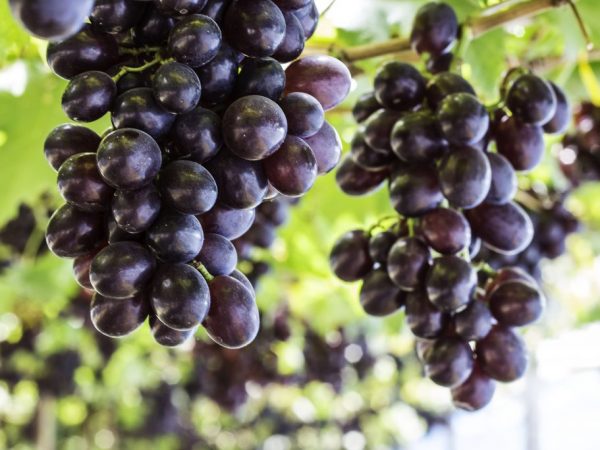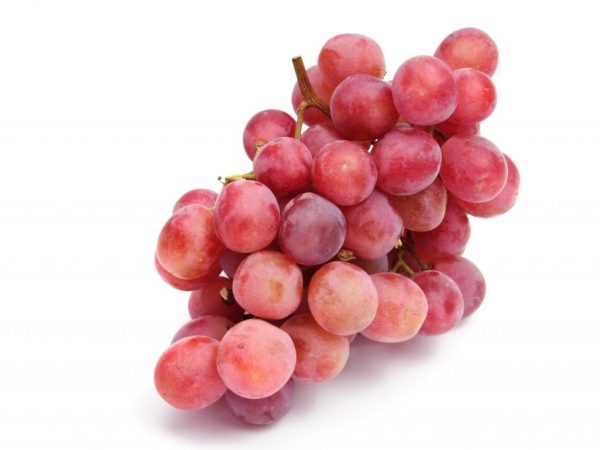Description of new varieties of grapes 2019
Some summer residents began to grow vines on the plots more and more often. Today it has become much easier to grow this culture: the new grape varieties of 2019 meet all the requirements. They have not only varied taste characteristics, but also regional cultivation characteristics.

Description of new varieties of grapes 2019
Early
Thanks to the selection work of domestic scientists, novelties with early ripening periods have appeared on the horticultural market. Their period of reaching technical maturity is on average 100 days. Of all the variety, it is worth highlighting several of the best varieties.
Ruslan
A hybrid obtained from crossed Kuban and Zaporozhye Gift. It appeared as a result of the breeding work of V. Zagorulko. Its variety is tall, with male and female flowers. The mass of the berry is an average of 20 g. The weight of a large-fruited bunch of grapes is 0.8-0.9 kg. The berry pulp has a plum aftertaste. The species begins to yield crops after the 20th of August.
The advantages of the variety include:
- resistance to low temperatures (up to minus 23 ° С);
- high immunity to fungal diseases.
The disadvantage of a hybrid is that care is complicated by intolerance to excess moisture.
Lyolik
Hybrid Lyolik was developed by E. Pavlovsky on the basis of Baklanovsky variety and Hybrid-41. He is one of the tall plants. Berries are pink, weighing 8 g. A bunch of grapes weighs up to 1 kg.
Hybrid advantages:
- frost-resistant - tolerates frosts down to minus 24 ° С;
- has average resistance to powdery mildew and mildew.
The disadvantage is the heterogeneity of the bunch ripening.
Novoshakhtinsky Muscat
The grape hybrid was bred by the breeder E. Pavlovsky, crossing the Talisman and XVII-10-26. The bunch weighs from 500 to 600 g. Taste characteristics are high. The grapes are sweet. Ripening period - starting from August 15th.
The advantages of a hybrid include:
- long keeping quality with preservation of taste and presentation;
- average indicators of resistance to the most common diseases.
Among the minuses - the vine is often overloaded with bunches, therefore, in the process of cultivation, it requires rationing the number of ovaries.
Melting
The hybrid variety was bred by A. Golub by crossing Atlanta and Arcadia. Liana with male and female flowers. The berries are white.
Among the advantages:
- increased rates of resistance to major diseases;
- frost resistance - the hybrid tolerates frosts well down to minus 23 ° С.
Medium ripening
Mid-season varieties and hybrids ripen in 110-115 days. Some of the new grape varieties deserve special attention from gardeners in 2019.

Large pink berries
Leah
The table variety was bred by V. Zagorulko from the grape varieties Arcadia and Zaporozhye Atlant. Berries are white-pink.Each medium bunch weighs about 1 kg, but there are large-fruited - up to 2 kg.
The benefits include:
- increased indicators of winter hardiness (up to minus 21-23 ° С);
- average resistance to major infections.
The disadvantages of the species are considered by gardeners to be demanding on the regularity of watering and intolerance to excess moisture.
Prometheus
Hybrid variety V. Zagorulko, obtained by crossing Radiant raisins and Arcadia. Liana has predominantly female inflorescences. The color of the berries is pink.
Hybrid advantages:
- medium resistance to mildew and powdery mildew;
- tolerance to low temperatures (up to minus 21 ° С).
Ksenia
The result of the breeding work of V. Krainov. The vine is a vigorous plant. Large bunches weigh up to 1.5 kg. The berries are oblong in shape, the color is white with a pink tint. The flesh is crispy and sweet.
Among the advantages:
- high rate of resistance to major diseases;
- good keeping quality.
Carmen
Varietal variety bred by E. Pvvlovsky from Nadezhda AZOS and hybrid FVC-94-3. A vigorous liana has male and female flowers. The berries are oblong, reddish-purple in color. Average weight - 0.6-0.8 kg.
The disadvantage of the variety is the tendency of the vine to form an excessive number of bunches, therefore, in the process of leaving, it requires rationing the number of ovaries.
Late ripening
Mid-late varieties and hybrids bring the first harvest in 135-145 days, sometimes it takes up to 160 days for technical maturity.
The attention of gardeners in 2019 can be drawn to the following types of grapes.
Giant Anapsky
A vigorous, versatile variety that ripens after September 15th. The weight of the bunches is small - up to 0.3 kg. The color of the berries is white.
Ataman Pavlyuk
The result of the breeding work of V. Kapelyushny, obtained by crossing the Talisman and Black Autumn. Vigorous grape vine, with large-fruited clusters up to 2 kg.
The advantages of the variety are the absence of peas and good keeping quality.
Lavalle
French table type, suitable for cultivation in Russia. The bunches are heterogeneous: there are loose and dense ones. Large berries with a contrasting purple color. Has a number of disadvantages:
- unresistant to most diseases of fungal etiology;
- does not tolerate low temperatures and its sharp fluctuations.
Skorensky
The hybrid is obtained from crossed species Datie de Saint-Valier and Nimrang-x-Pocket. Refers to dining rooms. Bunches are large-fruited, weighing 0.5-0.7 kg. The color of the berries is red-violet.
The main advantage is high resistance to fungal infections.
For different regions
Breeders are actively working on the development of grape varieties that can be cultivated in various regions of Russia. Today, gardeners have the opportunity to choose one of the new types of fruit crops, taking into account the weather characteristics of the growing area.

Different grapes are grown in each region
For the Crimean Peninsula
The Crimean peninsula is the leader in the collection of domestic grapes. Here gardeners prefer to plant early species that ripen by mid-summer:
- Saba pearls. A variety that bears fruit with small, rounded berries. The color is amber-golden. The taste of the pulp has nutmeg notes. The bunches are characterized by looseness;
- Queen of the vineyard. Large-fruited species with large round amber-colored berries;
- Pink taifi. A variety with a bunch of purple-pink color elongated up to 25 cm. The shape of the berries is round.
For the Volga region
Gardeners of the Volga region in 2019 can choose one of the early varieties:
- Dzintars. A table variety with an ultra-early technical ripeness. Gives the first harvest in 90 days, and in greenhouse conditions - in 75 days. Bunches of medium size, weighing 200-300 g. Round berries, weighing 3 g each, amber-yellow color, flesh with honey flavor;
- Silvia. A variety with a very early ripening period. The berries are ovoid and pinkish. Form medium-sized bunches weighing 0.4-0.7 kg.The pulp is firm, very sweet;
- Super extra. A vigorous hybrid with large, 500-800 g, clusters. Berries are oval in shape, weighing 7-10 g, green-yellow color. The pulp is fleshy, sweet.
For Moscow region
Winegrowers of the Moscow Region should pay attention to the following varieties and hybrids:
- F-14-75. A medium-sized liana gives clusters of 250-300 g. The berries are round, creamy pink in color. The taste is nutmeg. Differs in increased frost resistance (withstanding a drop in temperature to minus 26 ° C);
- Cherry. Table hybrid with early ripening. Yields harvests in 100-110 days. Frost resistant. The bunch is small (weighing 150-350 g), medium density. Rounded berries.
For the Urals
Residents of the Urals can choose early grape varieties for planting:
- Beauty of the North. The hybrid ripens in 110-115 days. Refers to vigorous. Differs in increased winter hardiness (withstands temperatures up to minus 26 ° C). The average weight of a bunch is 250-500 g. The berries are round, white-pink in color. The pulp is fleshy, with a tart aftertaste;
- Very early white muscat. Technical grade with a higher (more than 25%) sugar content. The bunch weighs about 380 g. The berries are round, golden yellow in color. The pulp has a citrus flavor.
For Siberia
Winegrowers of Siberia should pay attention to the following varieties:
- Rusven. Table pink grapes with early ripeness. Ripens in 110-115 days. Large-fruited, the average weight of berries is 50 g. The pulp has a clary sage flavor and is distinguished by an increased (up to 20%) sugar content;
- Very early red nutmeg. Gives first harvests after 90-100 days. Bunches of medium size, weighing 300-500 g. Frost-resistant species (tolerates a drop in temperature to minus 26 ° C).
Such a characteristic as frost resistance is important when choosing a variety for planting in the harsh climate of Siberia.
Harvest new items
New varieties of grapes from mothers often show high yields while maintaining high palatability. The top ten includes the following types:
- Seedless VI – 4. The table hybrid ripens 140 days after the formation of the ovaries. Has elongated white berries, large clusters;
- Lowland-2. Table grapes. The bunch grows up to 2 kg in weight. The berries are large, light purple in color. There is a slight sourness in the pulp;
- Veles. Nutmeg stands out from all types of sugary-sweet taste. It ripens in 120 days. Each bunch weighs about 1.5 kg. The berries are light pink.
Typical mistakes made by winegrowers
First, they choose a species that is not suitable for the climatic zone. This is a common mistake that leads to the death of a vine that is not adapted to certain regional characteristics. This is especially true for the northern regions, where sharp drops in temperatures are observed in winter.
Sometimes the vine does not have enough sunlight for the full ripening of the crop. When planting a species that is not suitable for the place of cultivation, the liana has a lower yield or simply does not take root.
Secondly, planting a new species in the same vineyard with other varieties is a common mistake. Newly acquired species are required to be planted for the first time separately from the rest of the vines. This will prevent contamination of diseases and prevent possible cross-pollination.

